My 5 Month Old Baby Has a Rash on His Face
Many things can cause a rash in babies and children, and they're often nothing to worry about.
Every bit a parent, y'all may know if your child seems seriously unwell and should trust your own judgement.
Rash with a loftier temperature
Rash on cheeks with high temperature

A rash on 1 or both cheeks plus a loftier temperature, runny nose, sore throat and headache may exist slapped cheek syndrome. After a few days, a rash may appear on their body.
Slapped cheek syndrome commonly gets better on its own within 3 weeks. Children's paracetamol or ibuprofen can bring down a high temperature.
Blisters on easily and anxiety plus mouth ulcers
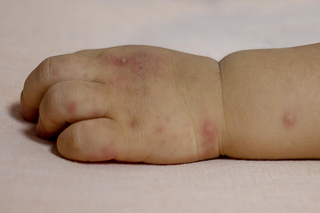
Hand, foot and mouth disease is a common childhood illness that causes blisters on the hands and feet, and ulcers in the mouth. It besides causes a high temperature and your child may have a sore throat.
It usually gets better in 7 to 10 days. Children'south paracetamol tin can bring down a high temperature.
Rash on the face and trunk
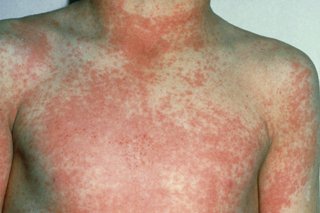
Scarlet fever causes a rash that looks similar pinpricks and feels crude, like sandpaper. The rash can be red, simply this may be less noticeable on chocolate-brown and black skin.
Scarlet fever normally starts with a white blanket on the natural language, a sore throat, headache and a loftier temperature.
See a GP immediately if you think your child has scarlet fever. Information technology'due south treated with antibiotics.
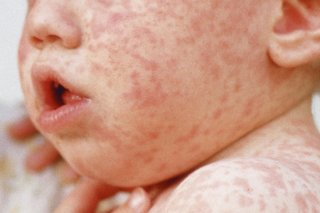
Measles commonly starts with the aforementioned symptoms as a common cold, plus a high temperature, sore eyes that are sensitive to low-cal and grayness spots within the cheeks.
Afterwards a few days, a spotty rash appears on the head or neck and spreads to the rest of the body. The spots tin appear red or brown, simply they may be less noticeable on brown and black skin.
Call a GP if yous think your child has measles.
Rash with itching
Rash caused by estrus

Heat and sweat can cause raised spots or patches known every bit prickly oestrus or heat rash. The rash tin expect blood-red, but information technology may be less noticeable on brownish or blackness peel.
It itches, so you may observe your kid scratching.
Heat rash usually gets meliorate on its own later a few days.
Scaly or cracked skin
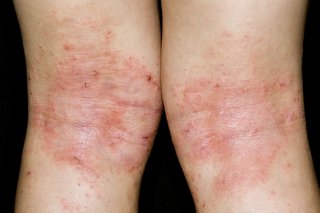

Skin that'due south itchy, dry and cracked may be atopic eczema. Information technology'due south common behind the knees, elbows and neck, but it can appear anywhere.
The afflicted area may change colour. On white skin, the expanse may look pink or cherry-red. On dark-brown and blackness skin, it may look grayness or purple, or darker than surrounding peel.
Speak to a GP if you lot think your kid has eczema.
Raised, itchy spots or patches
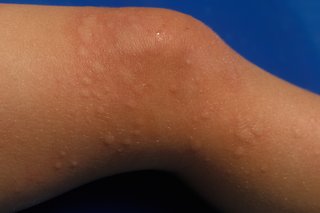
Hives causes a raised, itchy rash. It can look red, but this may exist less noticeable on brown and blackness skin.
The rash tin be a sign of an allergic reaction to things like a sting, medicine or food.
It usually gets amend within a few days.
Speak to a GP if your child keeps getting this type of rash. They may be allergic to something.
Call 999 if there's swelling effectually their mouth.
Itchy circular rash

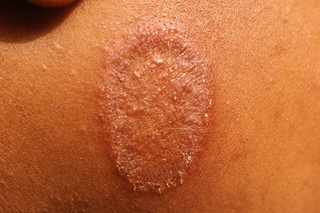
An itchy, dry, band-shaped patch of skin may be ringworm. The patch may expect red, pink, silver, or darker than surrounding skin.
Ask a chemist for a foam or lotion to treat ringworm.
Speak to a GP if it appears on your kid's scalp, as it may demand to be treated with prescription medicine.
Pocket-sized spots and blisters

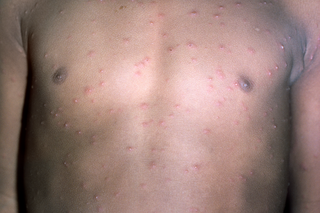
Chickenpox starts with small, itchy spots. The spots may look red, pink, the same colour or darker than surrounding skin, depending on your kid'southward peel tone. At the start, the spots may be harder to meet on brown and blackness pare.
The spots quickly form blisters and then scabs.
Some children have a few spots, while others accept them all over their body.
Itchy sores or blisters
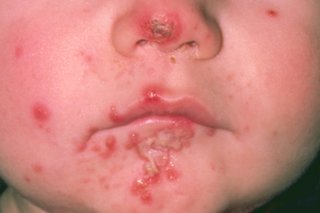
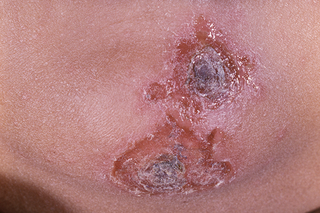
Ruddy sores or blisters that burst and get out crusty, golden-brown patches could exist impetigo. The redness may be harder to see on brown and black pare.
The sores or blisters can exist itchy, get bigger or spread to other parts of the body. They ofttimes appear on the face, hands or around the middle of the torso.
Speak to a GP if you remember your child may take impetigo.
Tiny and very itchy spots

Scabies is caused past tiny mites that burrow into the skin.
Ask a pharmacist for a cream or lotion to treat scabies. Everyone in the household needs to be treated at the same fourth dimension – even if they practise non have symptoms.
You lot should take your infant to a GP for advice if they are under 2 months quondam.
Rash without fever or itching
Tiny spots on a babe'due south face up

Very small spots, called milia, often appear on a baby's face when they're a few days old.
Milia may appear white or yellow, depending on your baby's skin tone.
They commonly go away within a few weeks and do not need handling.
Red, yellow and white spots in babies
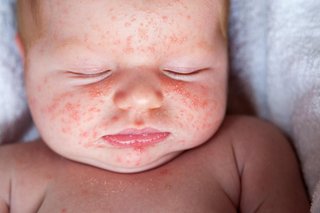
Raised red, xanthous and white spots (erythema toxicum) can appear on babies when they're built-in. They usually appear on the face, body, upper arms and thighs.
The rash can disappear and reappear.
It should get better in a few weeks without treatment.
Pink or pare-coloured spots
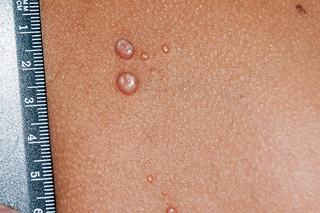
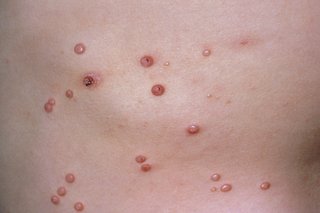
Small, firm, raised spots that can announced anywhere on the body are common in children and known as molluscum contagiosum.
The spots can exist the same color as surrounding peel, darker than surrounding pare, or pink.
Treatment is not recommended considering the spots get better on their own, although it tin can accept more than a year.
Cerise patches on a infant's bottom
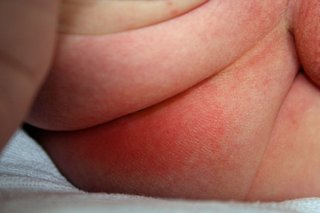
With nappy rash your baby'southward peel may wait sore and experience hot. There may exist red patches on your baby'southward bottom or around the whole nappy area.
There may be spots or blisters. It can make your child experience uncomfortable or distressed.
Yous can buy cream from a pharmacy to aid.
Pimples on the cheeks, nose and forehead
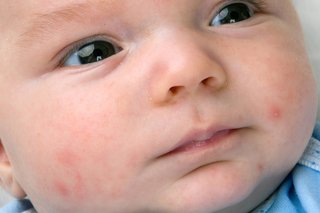
Baby acne tin appear within a month after birth simply usually gets better after a few weeks or months.
Washing your infant's face with water and a mild moisturiser tin can help.
Practise not use acne medicines intended for older children and adults.
Yellow, scaly patches on the scalp
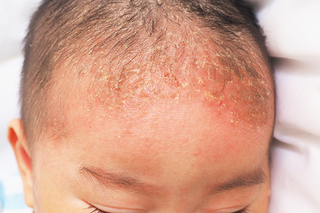
Cradle cap is when a infant gets yellow or white, greasy, scaly patches on their scalp.
It usually gets amend without treatment in a few weeks or months.
Gently washing your infant's hair and scalp with baby shampoo may help forbid more than patches.
Page concluding reviewed: 11 June 2021
Side by side review due: 11 June 2024
Source: https://www.nhs.uk/conditions/rashes-babies-and-children/
0 Response to "My 5 Month Old Baby Has a Rash on His Face"
Post a Comment